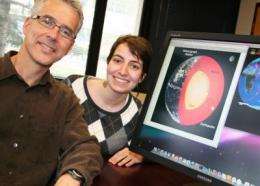Scientists probe Earth's core

We know more about distant galaxies than we do about the interior of our own planet. However, by observing distant earthquakes, researchers at the University of Calgary have revealed new clues about the top of the Earth's core in a paper published in the May edition of the journal Physics of the Earth and Planetary Interiors.
Knowledge of the composition and state in this zone is key to unraveling the source of the Earth's magnetic field and the formation of our planet.
"Some scientists have proposed a region of sediment accumulation at the top of the core, or even distinct liquid layers, but this study shows that the outer core is, in fact, well mixed," says professor Dave Eaton, co-author of the paper. "This inaccessible region is composed of molten iron, nickel and other as-yet unknown lighter elements such as silicon, sulfur, carbon or oxygen."
To help try and determine the materials that make up the Earth's core, which is 2,891 km below the surface, Eaton and co-author Catrina Alexandrakis, University of Calgary PhD student, measured the seismic wave speed (speed of sound) at the top of Earth's core.
"Observation of distant earthquakes is one of the few tools that scientists have to investigate deep parts of the Earth," says Alexandrakis. "This isn't the first time earthquake data has been used, but our research method is the most definitive to date."
The researchers' method is based on 'listening' to earthquakes on the other side of the planet using an approach that is akin to hearing a conversation across a whispering gallery, such as those in the domes of some large cathedrals.
Using a novel digital processing approach, they analyzed faint signals, produced by 44 earthquakes, and were able to measure the sound speed at the top of Earth's core with unprecedented accuracy.
Their results will help to guide research efforts at laboratories where core composition is studied by simulating extreme pressure and temperature conditions that exist in the Earth's core.
More information: Precise seismic-wave velocity atop Earth's core: No evidence for outer-core stratification by Catherine Alexandrakis and David Eaton is published in the journal Physics of the Earth and Planetary Interiors: dx.doi.org/10.1016/j.pepi.2010.02.011
Provided by University of Calgary













